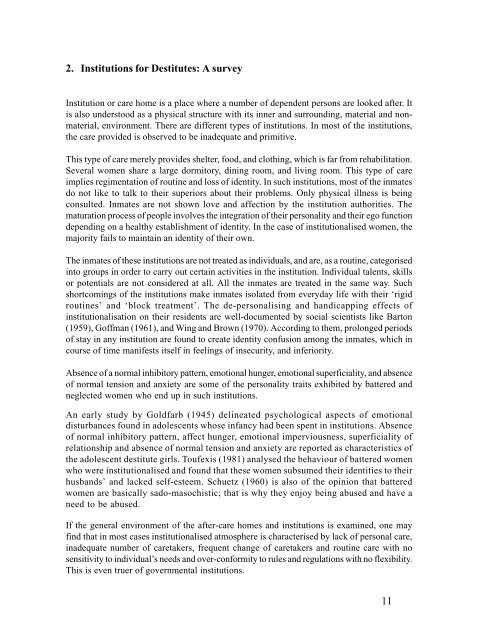Destitute Women in Kerala: Psychological resources and psycho ...
Destitute Women in Kerala: Psychological resources and psycho ...
Destitute Women in Kerala: Psychological resources and psycho ...
You also want an ePaper? Increase the reach of your titles
YUMPU automatically turns print PDFs into web optimized ePapers that Google loves.
2. Institutions for <strong>Destitute</strong>s: A survey<br />
Institution or care home is a place where a number of dependent persons are looked after. It<br />
is also understood as a physical structure with its <strong>in</strong>ner <strong>and</strong> surround<strong>in</strong>g, material <strong>and</strong> nonmaterial,<br />
environment. There are different types of <strong>in</strong>stitutions. In most of the <strong>in</strong>stitutions,<br />
the care provided is observed to be <strong>in</strong>adequate <strong>and</strong> primitive.<br />
This type of care merely provides shelter, food, <strong>and</strong> cloth<strong>in</strong>g, which is far from rehabilitation.<br />
Several women share a large dormitory, d<strong>in</strong><strong>in</strong>g room, <strong>and</strong> liv<strong>in</strong>g room. This type of care<br />
implies regimentation of rout<strong>in</strong>e <strong>and</strong> loss of identity. In such <strong>in</strong>stitutions, most of the <strong>in</strong>mates<br />
do not like to talk to their superiors about their problems. Only physical illness is be<strong>in</strong>g<br />
consulted. Inmates are not shown love <strong>and</strong> affection by the <strong>in</strong>stitution authorities. The<br />
maturation process of people <strong>in</strong>volves the <strong>in</strong>tegration of their personality <strong>and</strong> their ego function<br />
depend<strong>in</strong>g on a healthy establishment of identity. In the case of <strong>in</strong>stitutionalised women, the<br />
majority fails to ma<strong>in</strong>ta<strong>in</strong> an identity of their own.<br />
The <strong>in</strong>mates of these <strong>in</strong>stitutions are not treated as <strong>in</strong>dividuals, <strong>and</strong> are, as a rout<strong>in</strong>e, categorised<br />
<strong>in</strong>to groups <strong>in</strong> order to carry out certa<strong>in</strong> activities <strong>in</strong> the <strong>in</strong>stitution. Individual talents, skills<br />
or potentials are not considered at all. All the <strong>in</strong>mates are treated <strong>in</strong> the same way. Such<br />
shortcom<strong>in</strong>gs of the <strong>in</strong>stitutions make <strong>in</strong>mates isolated from everyday life with their ‘rigid<br />
rout<strong>in</strong>es’ <strong>and</strong> ‘block treatment’. The de-personalis<strong>in</strong>g <strong>and</strong> h<strong>and</strong>icapp<strong>in</strong>g effects of<br />
<strong>in</strong>stitutionalisation on their residents are well-documented by social scientists like Barton<br />
(1959), Goffman (1961), <strong>and</strong> W<strong>in</strong>g <strong>and</strong> Brown (1970). Accord<strong>in</strong>g to them, prolonged periods<br />
of stay <strong>in</strong> any <strong>in</strong>stitution are found to create identity confusion among the <strong>in</strong>mates, which <strong>in</strong><br />
course of time manifests itself <strong>in</strong> feel<strong>in</strong>gs of <strong>in</strong>security, <strong>and</strong> <strong>in</strong>feriority.<br />
Absence of a normal <strong>in</strong>hibitory pattern, emotional hunger, emotional superficiality, <strong>and</strong> absence<br />
of normal tension <strong>and</strong> anxiety are some of the personality traits exhibited by battered <strong>and</strong><br />
neglected women who end up <strong>in</strong> such <strong>in</strong>stitutions.<br />
An early study by Goldfarb (1945) del<strong>in</strong>eated <strong>psycho</strong>logical aspects of emotional<br />
disturbances found <strong>in</strong> adolescents whose <strong>in</strong>fancy had been spent <strong>in</strong> <strong>in</strong>stitutions. Absence<br />
of normal <strong>in</strong>hibitory pattern, affect hunger, emotional imperviousness, superficiality of<br />
relationship <strong>and</strong> absence of normal tension <strong>and</strong> anxiety are reported as characteristics of<br />
the adolescent destitute girls. Toufexis (1981) analysed the behaviour of battered women<br />
who were <strong>in</strong>stitutionalised <strong>and</strong> found that these women subsumed their identities to their<br />
husb<strong>and</strong>s’ <strong>and</strong> lacked self-esteem. Schuetz (1960) is also of the op<strong>in</strong>ion that battered<br />
women are basically sado-masochistic; that is why they enjoy be<strong>in</strong>g abused <strong>and</strong> have a<br />
need to be abused.<br />
If the general environment of the after-care homes <strong>and</strong> <strong>in</strong>stitutions is exam<strong>in</strong>ed, one may<br />
f<strong>in</strong>d that <strong>in</strong> most cases <strong>in</strong>stitutionalised atmosphere is characterised by lack of personal care,<br />
<strong>in</strong>adequate number of caretakers, frequent change of caretakers <strong>and</strong> rout<strong>in</strong>e care with no<br />
sensitivity to <strong>in</strong>dividual’s needs <strong>and</strong> over-conformity to rules <strong>and</strong> regulations with no flexibility.<br />
This is even truer of governmental <strong>in</strong>stitutions.<br />
11










